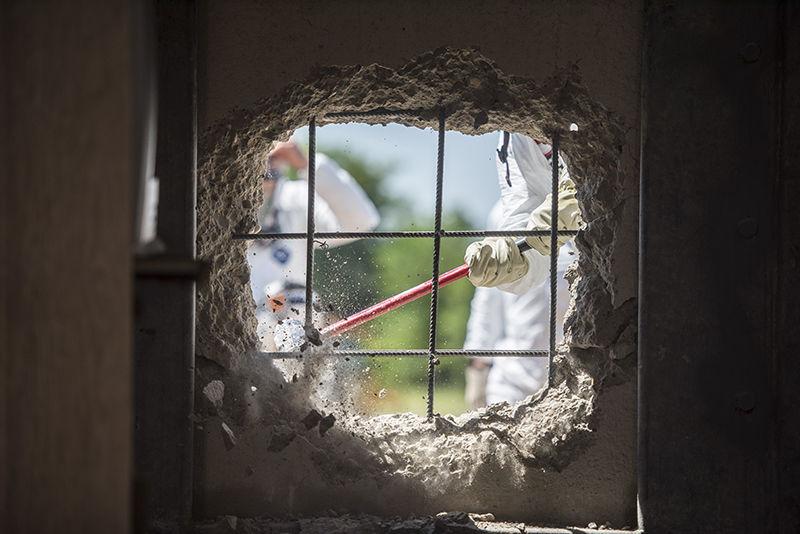On a cloudless 86-degree Saturday afternoon, screams could be heard echoing from the basement of a collapsed single family home as search-and-rescue teams got their bearings with time working against them.
The screams (from volunteers in makeup) and the home (staged as part of a simulation) are central to the notion tying the training exercise together — to best equip first responders, they must have the most realistic training possible.
Unstable walls, collapsed ceilings and roofs, mangled vehicles and various household items were the only remnants of the home, constructed to model damage from a tornado spawned from a hurricane.
Emergency personnel ranging from Hazmat teams to medical teams and military perused the perimeter, clad in white contamination suits and respirators with Rottweilers and Geiger counters by their side — their goal being to rescue as many people as possible in as little time as possible.
This is Disaster City.
Built in 1998 in response to the Oklahoma City bombings, Disaster City serves to train responders using near-lifelike conditions. Texas Task Force 1 manager Jeff Saunders said this year’s demonstration, performed Saturday, is based on a scenario that is trying to exercise urban search and rescue in a contaminated environment.
“We’ve got a little bit of chemical contamination that we would see from storm surge or heavy flooding,” Saunders said. “And we also have a small radioactive source that’s in that box sitting on the pile right there — that yellow tool box. There’s a radiological source from Dr. Mariano’s program over in nuclear science.”
Emphasizing the importance of an orchestrated and timely response, Texas A&M Engineering
manager William Welch said any disaster is a local disaster.
“If Snook had a disaster and they called for additional support and that support was Texas Task Force 1 or Forest Service or any of these entities, they would come in and be below the local jurisdiction,” Welch said. “Every disaster is always local. That local jurisdiction may employ an incident management team to help them mitigate the disaster.”
Welch said most local jurisdictions could remain independently effective for approximately 12 hours, after which Texas Task Force 1 or other specialized disaster response forces will move in as well.
“At the second operational cycle, task force has arrived and gotten set up, bringing specialized tools and skill sets that they have to operate in these environments,” Welch said.
Saunders said this exercise has been in the works for three years now, with three different teams participating in similar exercises. He said the exercises are important because the Federal Emergency Management Agency task force teams looks at all personnel to operate in these sorts of environments.
“We want to be able to prove to ourselves that we can do that,” Saunders said. “And then also if there are any gaps we see from the exercise then we can address those gaps in additional training.”
Beyond simply completing the exercises, Saunders said communication is key to developing the most efficient response effort possible.
“When we’re on scene, very rarely do we operate by ourselves,” Saunders said. “Any really large incident is going to have numerous different agencies and usually the failure points are not the skill level of the responders, the failure points are a breakdown in communication. So what this exercise is all about is the human interaction and making sure that we’re communicating with everyone correctly.”
In addition to training human personnel, Disaster City, in collaboration with the Texas A&M veterinary medicine program, is also on the forefront of developing techniques for search-and-rescue dogs as well as how to deal with any animals found in the wreckage.
Angela Clendenin, communications director in the College of Veterinary Medicine and Biomedical Sciences, said the program developed in 2010 in response to Hurricane Rita. Initially focused on sheltering, the vet med program reached out to Texas Task Force 1 to gauge the health and operations of their rescue dogs.
“We have a graduate student who now works full time with a vet that designed a decontamination unit,” Clendenin said. “Other states are asking for the blueprints and things like that because they don’t have anything like it.”
Less than a year after Hurricane Rita, the fires in Bastrop further spurred development of the training program.
“When you look at this environment that the dogs are working in now, imagine that it was covered in hot burning embers and ash,” Clendenin said. “They had booties for their dogs but the dogs didn’t like them, and they were kind of low so the dogs were tearing them off. We actually did pre-operational exams on them. We developed a new booting system that kind of came up higher so they couldn’t get them off as easy, and then we did hydration checks throughout the day and then their post-operational period exam.”
Clendenin said, according to the Task Force, their search-and-rescue dogs are subjected to grueling environments and could remain operational for two to three days before needing to be rotated out.
After running the pre-operational exams, the vet med program was able to increase the operational effectiveness of these dogs to four to six days — nearly double the original time in the field.
“This lets Task Force do their job more quickly, more efficiently and they find more bodies and save more lives,” Clendenin said.
Overall, Saunders said everything going on at Disaster City applies to every sort of disaster situation imaginable.
“We basically create a world and a storyline for the exercise scenario, but last year’s was based off a gas line explosion, and the gas line explosion did all this damage with the same kind of contamination and all the rest of the stuff,” Saunders said. “It’s not the story, it’s what you end up with.”




















